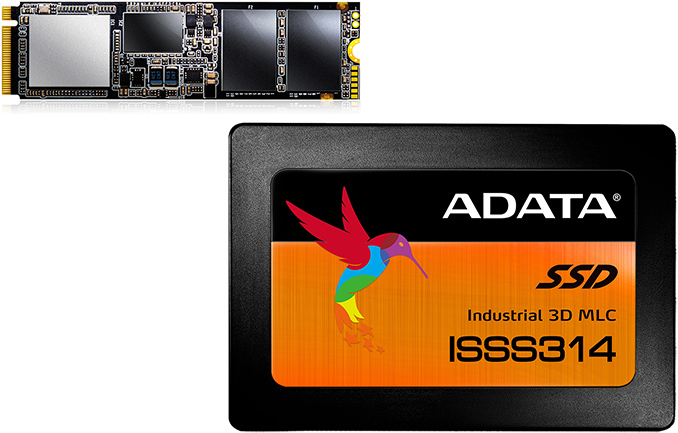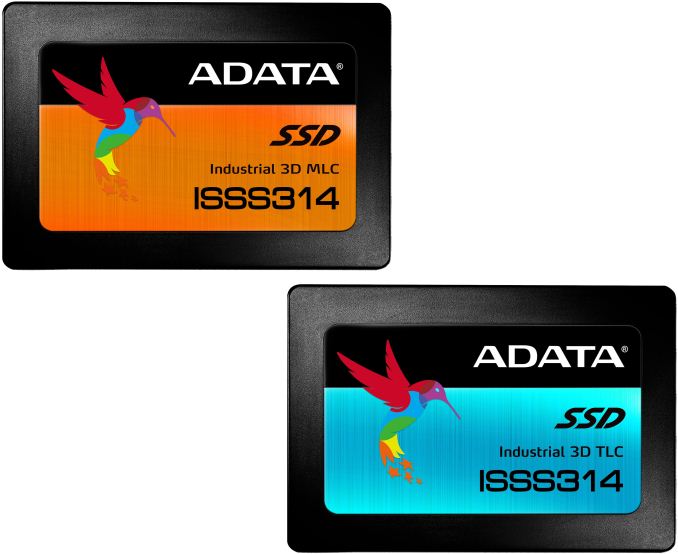ADATA Launches ISSS314 and IM2P3388 Industrial SSDs: 3D NAND, Extreme Temps
by Anton Shilov on July 20, 2017 4:00 PM EST
ADATA has introduced two new families of 3D NAND-based SSDs aimed at industrial applications. Dubbed the ISSS314 and the IM2P3388, these drives are designed to handle extreme temperatures as well as humidity levels, allowing them to work reliably in very tough environmental conditions. The more powerful IM2P3388 drives use a PCIe interface and offer high performance levels along with a powerful ECC engine and encryption, whereas the less speedy ISSS314 uses a SATA interface and offers very low power consumption that barely tops 2.5 W.
The IM2P3388: M.2, High Performance, Extreme Temps, Encryption, TCG Opal
The ADATA IM2P3388 is an M.2 drive that uses a NVMe PCIe 3.0 x4 interface and is based on 3D MLC NAND. This specific drive is designed to withstand ESD and EMI, up to 20 G vibration and 1500G/0.5ms shock, extreme temperatures from –40°C to +90°C, as well as high humidity (5%-95% RH, non-condensing). To put it into perspective: the IM2P3388 drives can operate in Antarctica or in the Lut Desert in Iran. In the real world, ADATA’s new SSDs will serve inside space-constrained industrial or commercial PCs, servers, military-grade systems, and embedded computers.
The IM2P3388 drives are based on a Silicon Motion controller that ADATA does not name, we suspect is the SM2260 with some additional customization. As for the NAND, the IM2P3388 SSDs use carefully selected 3D MLC that can handle high temperatures for prolonged amounts of time. The IM2P3388 takes advantage of all the capabilities of the controller and therefore supports AES-256 encryption, TCG Opal 2.0 spec, end-to-end data protection, and so on. In addition, the drive has multiple sensors that monitor its condition.
| ADATA IM2P3388 SSD Specifications | |||||
| Capacity | 128 GB | 256 GB | 512 GB | 1 TB | |
| Model Number | Commercial | IM2P3388-128GB | IM2P3388-256GB | IM2P3388-512GB | IM2P3388-001TB |
| Industrial | IM2P3388-128GC | IM2P3388-256GC | IM2P3388-512GC | IM2P3388-001TC | |
| Controller | Silicon Motion SM2260 (?) | ||||
| NAND Flash | 3D MLC NAND | ||||
| Form-Factor, Interface | M.2-2280, PCIe 3.0 x4, NVMe 1.2 | ||||
| Operating Temperature | Commercial | -10°C to 80°C | |||
| Industrial | -40°C to C to 90°C | ||||
| Vibration Resistance | 20G (10 - 2000 Hz) | ||||
| Shock Resistance | 1500G/0.5 ms half sine wave | ||||
| Operating Humidity | 5% - 95% RH non-condensing | ||||
| Sequential Read | ~1000 MB/s (?) | ~2000 MB/s (?) | 2500 MB/s | ||
| Sequential Write | ~300 MB/s (?) | ~600 MB/s (?) | 1100 MB/s | ||
| Random Read IOPS | unknown | ||||
| Random Write IOPS | unknown | ||||
| Pseudo-SLC Caching | Supported | ||||
| DRAM Buffer | Yes, capacity unknown | ||||
| TCG Opal Encryption | Yes | ||||
| Power Consumption | Up to 4.8W | ||||
| Power Management | DevSleep, Slumber | ||||
| Warranty | unknown | ||||
| MTBF | >2,000,000 hours | ||||
As for performance, ADATA specifies the drive to offer up to 2.5 GB/s sequential read speeds and up to 1.1 GB/s sequential write speeds (when pSLC caching is used), but does not specify random performance. ADATA’s IM2P3388 will be available in 128 GB, 256 GB, 512 GB, and 1 TB configurations. Keeping in mind the high density of modern flash chips, expect the entry-level models to be slower than their higher-capacity counterparts. In general, expect performance of the IM2P3388 to be comparable to the XPG SX8000 drives featuring the SM2260 and 3D MLC.
The ISSS314: 2.5”, Extreme Temps, Low Power, Starting at 32 GB
The ADATA ISSS314 SSDs come in a traditional 2.5”/7 mm drive form-factor and use a SATA 6 Gbps interface. In order to satisfy the diverse needs of customers, ADATA will offer the ISSS314 in 32 GB, 64 GB, 128 GB, 256 GB, and 512 GB configurations. The higher-end models will provide up to 560 MB/s sequential read and up to 520 MB/s sequential write speeds, whereas the entry-level drives will be considerably slower. As for power consumption, the new SSDs are rated to only use up to 2.5 W, which puts them into the energy efficient category.
The ISSS314 SSDs are based on an unknown controller as well as 3D MLC and 3D TLC NAND memory sorted using ADATA’s proprietary A+ testing methodology to find the higher quality chips. The industrial ISSS314 drives based on 3D MLC memory are rated to withstand shock, EMI, and extreme temperatures from –40°C to +85°C, and thus are aimed at industrial applications. By contrast, commercial 3D MLC ISSS314 SSDs are rated for –10°C to +80°C operation. Meanwhile, the 3D TLC-powered ISSS314 is guaranteed to work in a temperature range from 0°C to +70°C, but can also withstand shocks, ESD, EMI, and so on. As for features, all the ISS314 SSDs have S.M.A.R.T, a temperature sensor, hardware power detection, and flash protection.
| ADATA ISSS314 Specifications | |||||||
| Capacity | 32 GB | 64 GB | 128 GB | 256 GB | 512 GB | ||
| Model Number | MLC | Commercial | ISSS314-032GB | ISSS314-064GB | ISSS314-128GB | ISSS314-256GB | ISSS314-512GB |
| Industrial | ISSS314-032GC | ISSS314-064GC | ISSS314-128GC | ISSS314-256GC | ISSS314-512GC | ||
| TLC | Commercial | - | ISSS314-128GD | ISSS314-256GD | ISSS314-512GD | ||
| Controller | Silicon Motion SM2258 (?) | ||||||
| Form-Factor/Interface | 2.5"/7 mm/SATA | ||||||
| NAND | MLC | Commercial | 3D MLC | ||||
| Industrial | 3D MLC | ||||||
| TLC | Commercial | - | 3D TLC | ||||
| Operating Temp. | MLC | Commercial | -10°C to 80°C | ||||
| Industrial | -40°C to C to 85°C | ||||||
| TLC | Commercial | 0°C to 70°C | |||||
| Vibration Resistance | 20G (10 - 2000 Hz) | ||||||
| Shock Resistance | 1500G/0.5 ms half sine wave | ||||||
| Operating Humidity | 5% - 95% RH non-condensing | ||||||
| Sequential Read | unknown | 560 MB/s | |||||
| Sequential Write | unknown | 520 MB/s | |||||
| Random Read IOPS | Up to 90K IOPS (taken from SM2258, actual will be lower) | ||||||
| Random Write IOPS | Up to 80K IOPS (taken from SM2258, actual will be lower) | ||||||
| Pseudo-SLC Caching | Supported | ||||||
| DRAM Buffer | Yes, capacity unknown | ||||||
| TCG Opal Encryption | No | ||||||
| Power Consumption | Up to 2.5W | ||||||
| Power Management | DevSleep | ||||||
| Warranty | unknown | ||||||
| MTBF | 2,000,000 hours | ||||||
ADATA does not publish recommended prices for its industrial and commercial SSDs. Since such products rarely show up in mainstream retail, their actual prices for customers typically fluctuate depending on the order size and other factors.
Related Reading:
- Transcend Introduces Extreme Temperature DDR4 SO-DIMMs
- Logic Supply ML100G-50 Fanless Skylake vPro Industrial NUC Review
- ADATA Launches XPG SX8000: High-End M.2 NVMe SSD Featuring 3D MLC NAND
- ADATA Announces XPG Gammix S10: 3D TLC, SM2260, 1.7 GB/s Seq. Read, Radiator
- ADATA Announces The XPG SX7000 Series SSDs: Up to 1 TB, M.2, PCIe 3.0 x4
- Previewing Silicon Motion SM2260 NVMe Controller With 3D MLC NAND (512GB)
- ADATA Announces Ultimate SU900: 3D MLC NAND, SMI Controller, SATA
- ADATA Introduces Ultimate SU800 SSD: SMI Controller, 3D NAND, SATA Interface












6 Comments
View All Comments
Bullwinkle J Moose - Friday, July 21, 2017 - link
"ADATA does not publish recommended prices for its industrial and commercial SSDs. Since such products rarely show up in mainstream retail, their actual prices for customers typically fluctuate depending on the order size and other factors."--------------------------------------------------------------------------------------------------------------
Even without prices, will they let Anandtech torture a few to see if they will outperform the Intel XPoint or whatever they will be calling it in their Commercial SSD space
I have a gut feeling that XPoint will outlive these Adata's at the extremes of temp
Push a few beyond their limits and see how well they hold up to XPoint and a Samsung 850 Pro as well
Industrial Consumers NEED TO KNOW!
Bullwinkle J Moose - Friday, July 21, 2017 - link
Push one drive to cold temp failure and one to high temp failure point during heavy use and compare the results with other brandsthen compare warranty and price !
Extreme Advertising should require Extreme Testing!
........and it might be entertaining for Extreme Users
damianrobertjones - Friday, July 21, 2017 - link
I cannot wait for the 4D drives!Lord of the Bored - Friday, July 21, 2017 - link
Ditto. Storing data across time should greatly increase performance.hectorsm - Monday, July 24, 2017 - link
Lord of the Bored...you made me laugh for a long time. Yes, the 4th dimension is believed to be the dimension of time.AndrewJacksonZA - Friday, July 21, 2017 - link
I'm with Bullwinkle J Moose. I think that it will not only be informative, but also entertaining to your readers. And I'm sure that it might be entertaining and challenging to the reviewer too! :-)